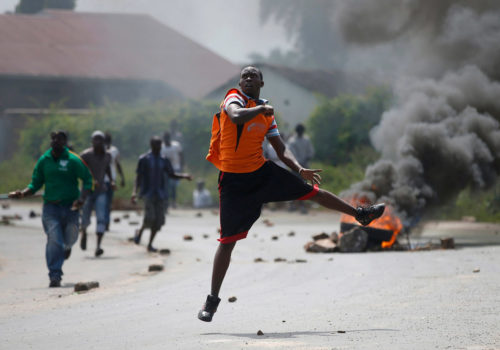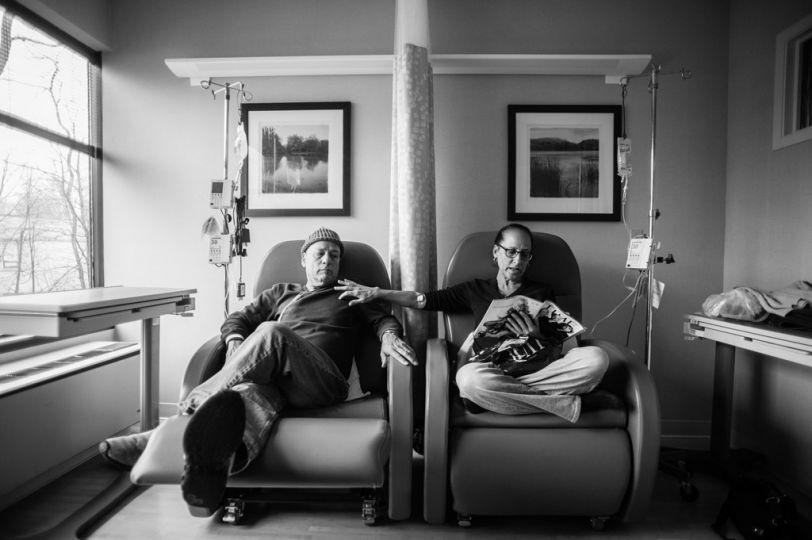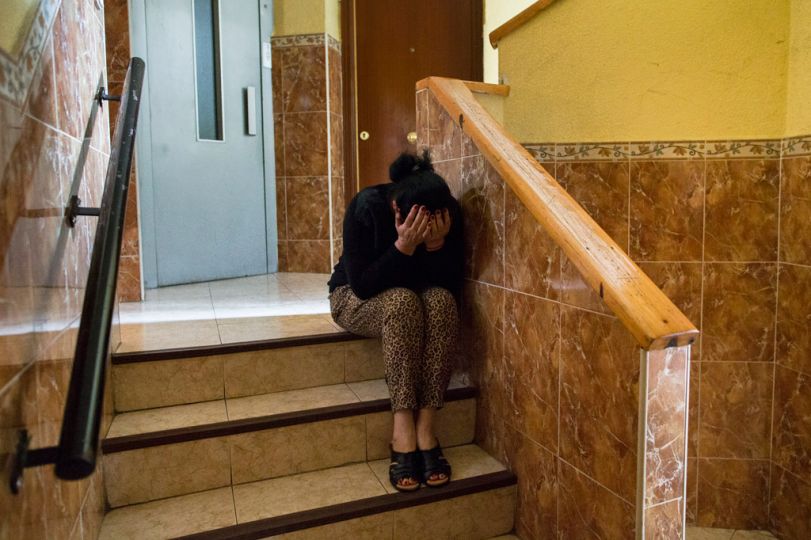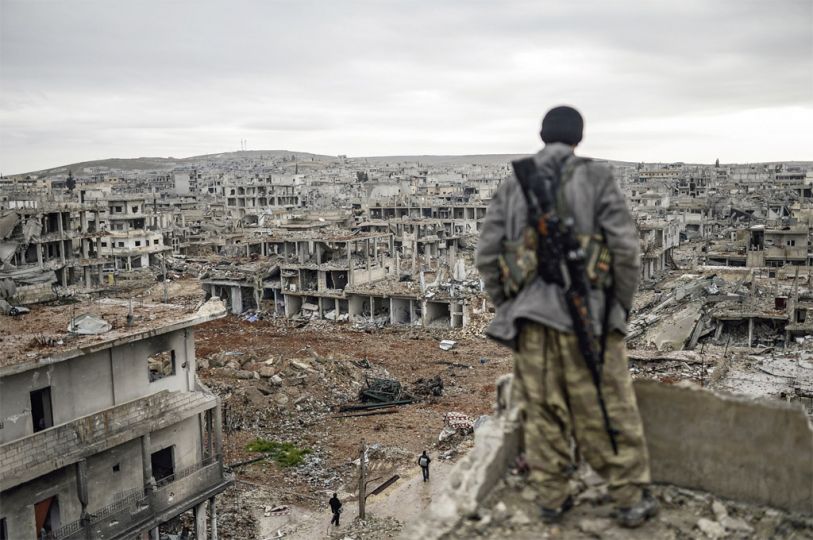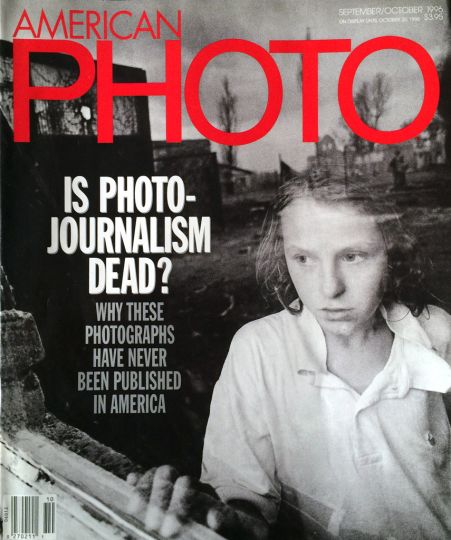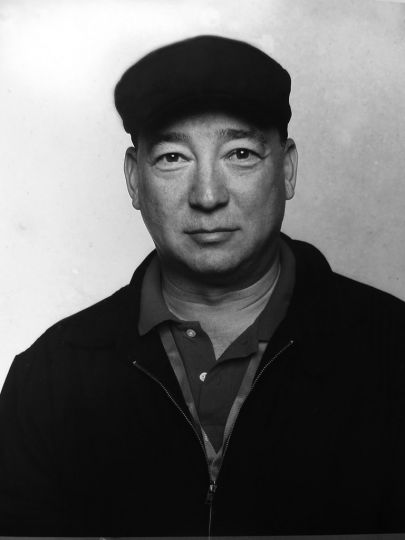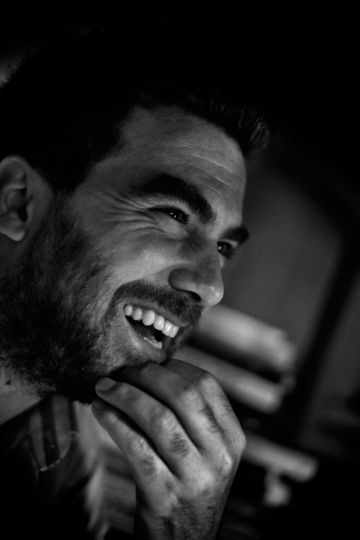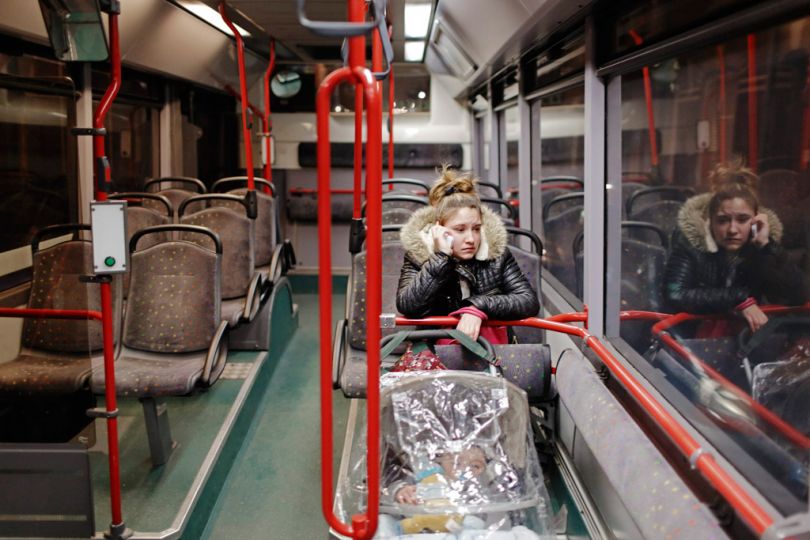The International Festival of Photojournalism Visa pour l’Image was inaugurated last Saturday. This week, the manifestation welcomes professionals from international photojournalism. Today, we present program of the 26 exhibitions presented until September 13th (free entrance).
• Mohamed Abdiwahab : Somalia
AFP
The exhibition shows the experience of the people of Somalia, a life shattered by attacks and rival gangs, where violence is part of everyday life – car bomb attacks and smoking wrecks, buildings in ruins – the stories of his reports. Al-Shabaab Islamists have been leading an insurrection in Somalia since 2007, with guerilla tactics and suicide bombers targeting key sites in Mogadishu, the capital.
• Lynsey Addario : Syrian Refugees in the Middle East
Getty Images Reportage
According to the UN High Commissioner for Refugees, some four million people have fled Syria since the beginning of the war and another 7,6 million are internally displaced. For this essay, Addario traveled to Syria, and to neighboring Turkey, Lebanon, Jordan, and Iraq.
• Diana Zeyneb Alhindawi : The Minova Rape Trials
(Winner of the Humanitarian Visa d’or award – International Committee of the Red Cross (ICRC) 2015)
Between February 12 and 19, 2014, a temporary courtroom was set up in Minova town, South Kivu Province in the Democratic Republic of Congo (DRC), to hear the testimony of rape victims living there. The fact that it was a military tribunal hearing criminal charges against a large number of members of the armed forces made this the most significant rape trial ever in the DRC, a country which one UN official has dubbed the “rape capital of the world.” Thirty-nine members of government forces were accused of crimes and acts of violence committed in a ten day rampage in November 2012, when they were fleeing rebels from the March 23 Movement who had captured the key city of Goma. In the course of those ten days, it is estimated that 1000 women, children and men were raped in Minova alone. For victims, there is great stigma associated with rape, so those who appeared in court were swathed in garments to conceal their identity, and even then only 47 women came forth to testify. In the ruling handed down on May 5, 2014, two soldiers were found guilty of rape.
• Arnaud Baumann (Sipa) & Xavier Lambours (Signatures) : From Hara-Kiri to Charlie Hebdo
A Project presented by Signatures, maison de photographes
In 1975, two young photographers set off to explore what was happening behind the scenes at France’s satirical magazine Hara-Kiri. Arnaud Baumann and Xavier Lambours followed the editorial team and the many fascinating figures in the entourage of the two leading personalities, Professor Choron and François Cavanna, who founded the first Charlie Hebdo. The duo, nicknamed Lambau, recorded birthday celebrations, practical jokes, and editorial meetings, and took portrait shots of such brilliant provocateurs as Gébé, Wolinski, Cabu, Willem and Reiser. It was the heyday for outrageous and challenging journalism enjoying true freedom of expression. After ten years without Charlie Hebdo, the second magazine with the same title came out in 1992. The exhibition shows the founding fathers and the generations that followed them, from Berroyer, Vuillemin and Gourio to the cartoonists Charb, Tignous and Honoré who were slaughtered, with Cabu and Wolinski, in January this year.
• Daniel Berehulak : The Ebola Epidemic
Getty Images Reportage / The New York Times
The Ebola epidemic in West Africa has been the largest outbreak of the virus ever recorded, claiming more than 10,000 lives. These images, made over four months in Liberia, Guinea and Sierra Leone, on assignment for The New York Times, chronicle the impact of the crisis: overwhelmed health workers, teeming treatment facilities, families and communities torn apart. They also attempt to capture less visible effects, such as the anxiety of living under quarantine, and the anguish of families who, for fear of contagion, could not provide their loved ones with proper burials. Above all, the photographs are a testament to the humanity of Ebola’s victims, and to the resilience of the health workers and civilians who struggled to care for them.
• Marcus Bleasdale : Terror in the Central African Republic
Human Rights Watch / National Geographic Magazine
While the media focused on more high-profile conflicts, thousands were killed in the Central African Republic and hundreds of thousands fled the country. Between October 2013 and February 2015, Marcus Bleasdale spent many months reporting there, in the midst of violence and hatred which had not been seen in Africa since Rwanda in 1994, as neighbors killed neighbors and reprisals continued. The conflict must not be forgotten. The abuses must be recorded.
• Nancy Borowick : Cancer Family, Ongoing
People truly understand and appreciate life when faced with their own mortality. Nancy Borowick defines this through her personal project, following both her parents in treatment for stage-four cancer, side by side. She looks at love, life, and living in the face of death. She honors their memory by focusing on their strength and love, individually and together, and shares the story of their final chapters.
• Juan Manuel Castro Prieto : Peru, the Sacred Valley
Agence VU’
In 1990, Juan Manuel Castro Prieto packed his black & white gear and set off for Peru to do enlarged versions of shots by the great Martín Chambi. He has since made many more trips to the country which is still a source of wonderment for him. The exhibition shows him following in the footsteps of Martín Chambi, the photographer he admires so much, using a large format view camera, exploring sites photographed by the master, seeking to understand his fascination for the Andes and the influence on his work and life.
• Alejandro Cegarra : Living with the Legacy of Hugo Chavez
Getty Images Reportage
On March 5, 2013 at 4:45pm, fourteen years after leading the Bolivarian Revolution to power, President Hugo Chavez died, leaving behind an orphaned revolution. His supporters wished to preserve the legacy of Hugo Chavez and his memory. But, what is the legacy of Hugo Chavez ?
• Viviane Dalles : Teenage Mothers
Canon Female Photojournalist Award 2014 supported by Elle Magazine
In 2014, in France, some 5,000 juvenile mothers aged 14 to 18 may not have chosen to be pregnant, but they choose to keep their babies, going against the trend in modern western societies, opting for motherhood and dropping out of school. The happiness of being a mother combines with the turmoil of teenage years as they embark on a new life. Many of these juvenile mothers are in the north of France, a disadvantaged area given more social support over recent years. Each mother has a different story to tell, but they are all determined to be good mothers, good teenage mothers.
• Manoocher Deghati : Facing Reality
Manoocher Deghati has been photographing news, conflicts and social issues around the globe since 1978, starting with the Iranian revolution and then war with Iraq in his native Iran. After being forced into exile in 1985, he worked for several major agencies, magazines, and the United Nations, in Central America, northern Africa, Sub-Saharan Africa, Asia, Europe, and the Middle East. In 2002, after the fall of the Taliban, he founded AINA Photojournalism Institute in Kabul. After directing photo operations for The Associated Press in the Middle East for four years, he is now freelancing from his new home base in southern Italy.
• Edouard Elias : The French Foreign Legion in the Central African Republic
Getty Images Reportage / Winner of the Ville de Perpignan Rémi Ochlik Award 2015
August 2014, Operation Sangaris, the French intervention in the Central African Republic, included Foreign Legion troops. Here we see them, in the oppressive atmosphere, working and waiting, up against an enemy often difficult to identify, and in a hostile tropical environment.
• Omar Havana : Earthquake in Nepal
Getty Images
On April 25, 2015, a 7.8 magnitude earthquake hit Nepal, killing almost 9,000, injuring 22,000, leaving hundreds of thousands homeless, and destroying historic monuments. Omar Havana has been based in Nepal since October 2014, and as a first-hand witness he hit the streets immediately, documenting the chaos and humanitarian disaster. His photographs highlight not only the pain and hardship endured by the people, but also their strength and commitment to rebuild the country and gradually get their lives back to normal.
• Bülent Kiliç : From Kiev to Kobané
AFP
Bülent Kiliç has worked extensively, from Maidan in Ukraine in 2014, to Turkey and Syria, and has won a number of awards: the Bayeux-Calvados Award for war correspondents, the National Press Photographers Association (NPPA, USA), the China International Press Photo Contest (CHIPP) and best agency photographer of the year for Time magazine and The Guardian. It is important for Visa pour l’Image- Perpignan to showcase his work. The Turkish photographer Bülent Kiliç (born in 1979) was first a journalist, working for the local press. In 2003, he became a reporter/photographer, and two years later began doing contract work for AFP. He is based in Istanbul where he is currently in charge of photography in Turkey for AFP.
• Andres Kudacki : Spain’s Housing Crisis
AP / Winner of the ANI – PixPalace Award 2015
In Spain, with over 26% unemployment, widespread pay cuts, and often no job security, thousands who can no longer afford to pay their home loans or rent are facing eviction. Others are victims of expropriation through real estate speculation, with links between private companies and the government. The most vulnerable have been hardest hit by the austerity measures. Social housing property is being sold off to private investors. The report covers the past three years, exploring the relationship between people and their homes, seeing how they have coped with evictions.
• Gerd Ludwig : Nuclear Tourism
National Geographic Creative / National Geographic Magazine
In 2011, as people around the world watched TV reports on the nuclear meltdown in Fukushima, the Ukrainian government gave approval for travel inside the Chernobyl exclusion zone which has now become a disaster-tourism destination. Tourists take pictures of the sarcophagus encasing the reactor, but the top attraction is the ghost town of Pripyat, once home to nearly 50,000, now decaying and overgrown by nature, a less than truthful witness to its sudden abandonment. Visitors and tour guides have set up tableaux to evoke scenes, e.g. a doll arranged next to a gas mask.
• Pascal Maitre : The Congo River Exploring a Legend
Cosmos / National Geographic Magazine
To travel along the Congo River is to explore a legend, one written by names such as Stanley, Joseph Conrad and V.S. Naipaul. Today, 140 years after Stanley’s expedition, the trip along the Congo River is a journey through modern-day Africa, with nearly 30 million living along its banks. The river and the tributaries are the only means of transport in the Congo Basin, forming a link of great social and economic importance. For most people in the region, there is no other option than to embark on a long journey, from five weeks to seven months, on barges carrying goods. It is a grueling and dangerous journey, and some 6,000 people have lost their lives in accidents and shipwrecks.
• Giulio Piscitelli : From There to Here: Immigration and Fortress Europe
Contrasto / Réa
Immigration to Europe has increased over the past thirty years, mainly because of political and social turmoil in the Middle East and sub-Saharan Africa. The past four years documenting the crisis have covered most countries concerned, at the doorway to Europe (Italy, Greece and Spain) and in transit (Libya, Tunisia, Egypt, Sudan, Serbia and Bulgaria). This is the tale of the catastrophic consequences of upheavals around the world and the European Union response to people in search of a safe place to live, far from war and poverty.
• Sergey Ponomarev : Assad’s Syria
for The New York Times
Life in a war environment in Syria. For four years now the people have become accustomed to the noise of explosions and artillery fire; for the citizens of Damascus it is as commonplace as the sound of traffic. In Homs, where the revolution started, the city center is closed off with roadblocks and checkpoints. Some neighborhoods are operational, but people live in fear, often in cramped quarters with displaced persons, or in the bombed ruins of buildings.
• Eli Reed : A Long Walk Home
Magnum Photos
“Eli Reed: A long Walk Home” is his first career retrospective, spanning five decades as seen in 261 photographs in the book: people from New York to California forming a collective portrait of the American experience; plus images of life and conflict in Africa, the Middle East, Central America, and South America; as well as portraits from Hollywood. Reed has received numerous awards and is currently Clinical Professor of Photojournalism at the University of Texas at Austin while continuing work on different projects.
• Stephanie Sinclair : Nepal’s Living Goddesses
for National Geographic Magazine
In the Kathmandu Valley, prepubescent Newari girls known as kumaris are worshipped as deities, endowed with foreknowledge, able to cure the sick, fulfill wishes, and bestow blessings for protection and prosperity. They are the link between earth and the realm of the divine, generating a spirit of loving kindness in their devotees. The photographic essay (for National Geographic) is a rare opportunity to see inside the world of these living goddesses.
• Adrienne Surprenant : The Future Nicaragua Canal
Hans Lucas
The Nicaragua Canal, to link the Atlantic and Pacific Oceans, and three times bigger than the Panama Canal, will be built by HKND, the Hong Kong Nicaragua Canal Development Group. The vast project will have a direct impact on local communities, in all nearly 30,000 people, most of them living on and from the land. With inadequate information and expropriation imminent, the situation has become tense. In December 2014, anti-canal protesters blocked three highways and met with a violent crackdown by police.
• Goran Tomasevic : Burundi, Three Times No
Reuters
Goran Tomasevic has spent more than twenty years travelling the globe covering major events. His reports on war and revolution have produced enduring images of the conflicts in the Balkans, Iraq, Afghanistan, Libya and Syria. In 2015, he spent six weeks in Burundi covering protests that plunged the country into chaos during the run-up to the presidential election with Pierre Nkurunziza running for an unprecedented third term – hence the title of the exhibition.
• Alfred Yaghobzadeh : Yazidi Women, Their Bodies a Battlefield
for Paris Match
On August 3, 2014, Islamic State fighters carried out a lightning offensive in the Sinjar mountains in northwestern Iraq, a region that is home to the Yazidi community, a Kurdish minority dating back to ancient Persia. Men captured by ISIS forces were executed; the women were raped and sold as slaves. In May 2015, a brigade of female Yazidi fighters was formed. These young women now fight on the front, with the men, “because we must only ever rely on ourselves, and we must defend ourselves to regain our honor ».
• 10th anniversary of the Ville de Perpignan Rémi Ochlik Award 2015
The City of Perpignan has been funding the Award for the Best Young Reporter since 2006. In 2012, we chose to change the name, adding “Rémi Ochlik” to commemorate the young photojournalist who had recently been killed in Syria. This year, the 10th anniversary of the award is an opportunity to present a selection of work by the award winners. They are all now established photographers, offering eloquent proof that talent and value do not have to age.

